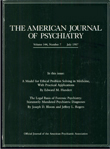A study of crying in medically and surgically hospitalized patients
Abstract
In a prospective study of hospitalized patients referred to a psychiatry consultation service, 46 patients were referred for a presumed diagnosis of depression because crying was a prominent symptom. Psychiatric consultation determined that 20% had a psychiatric disorder only, 33% had a neurological disorder only, 43% had both psychiatric and neurological disorders, and 4% had a previously undescribed entity, "essential" crying. The most common neurological disorder in these crying patients was bilateral hemispheric dysfunction associated with dementia or delirium; the most common psychiatric disorder was major depression. Effective therapy for patients who cry depends on proper identification of the cause of crying.
Access content
To read the fulltext, please use one of the options below to sign in or purchase access.- Personal login
- Institutional Login
- Sign in via OpenAthens
- Register for access
-
Please login/register if you wish to pair your device and check access availability.
Not a subscriber?
PsychiatryOnline subscription options offer access to the DSM-5 library, books, journals, CME, and patient resources. This all-in-one virtual library provides psychiatrists and mental health professionals with key resources for diagnosis, treatment, research, and professional development.
Need more help? PsychiatryOnline Customer Service may be reached by emailing [email protected] or by calling 800-368-5777 (in the U.S.) or 703-907-7322 (outside the U.S.).



